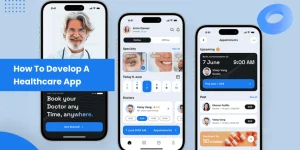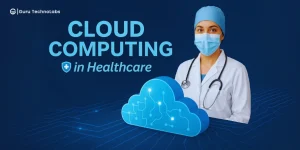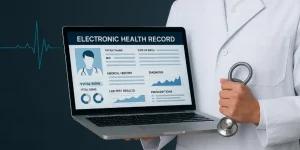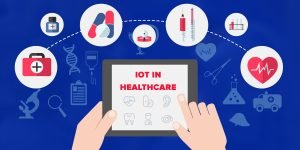Top 12 Healthcare Technology Trends for 2025 and Beyond
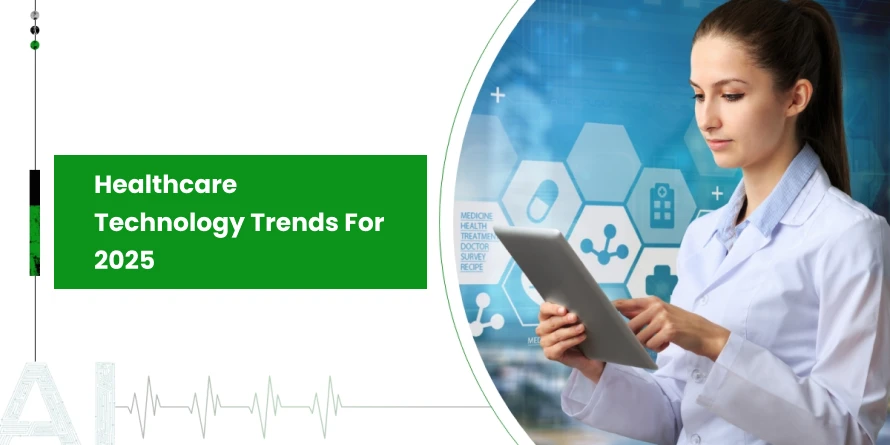
“Necessity is the mother of invention”. You can’t teach an old dog new tricks… This age-old saying could not be more appropriate looking back at 2020, a year that changed the world as we knew it. The COVID-19 pandemic became much more than a health crisis–it triggered rapid digital transformation in healthcare.
From telemedicine as the new norm and AI-fueled diagnostics transforming how we treat our patients to technological pivots changing healthcare business models that no one predicted.
As we emerge from the pandemic, these changes aren’t just some stitching- they are the fabric of the future. In this blog, we will deeply dive into 12 promising healthcare technology trends for 2025 and beyond, trends that seem here to stay as they push the evolution of the healthcare industry.
What Are Healthcare Technology Trends?
The healthcare technology trends are the emerging innovations and company capabilities that are changing the way that health services are delivered, managed, and experienced. These trends highlight the evolution of technology in various domains ranging from diagnostics, treatment and patient care to healthcare operations.
As an example, the emergence of telemedicine as a major game-changer, with the global telehealth market expected to exceed $175 billion by 2026. This transformation was mainly spurred by the pandemic, which compelled healthcare systems to transition rapidly to remote consultation.
These trends are not merely passing fancies — they’re changing the face of healthcare for good. Innovations such as wearable devices that capture real-time health data and AI-powered next-generation treatment plans are resulting in improved patient outcomes, reduced costs, and more accessibility than ever before.
12 Healthcare Technology Trends for 2025
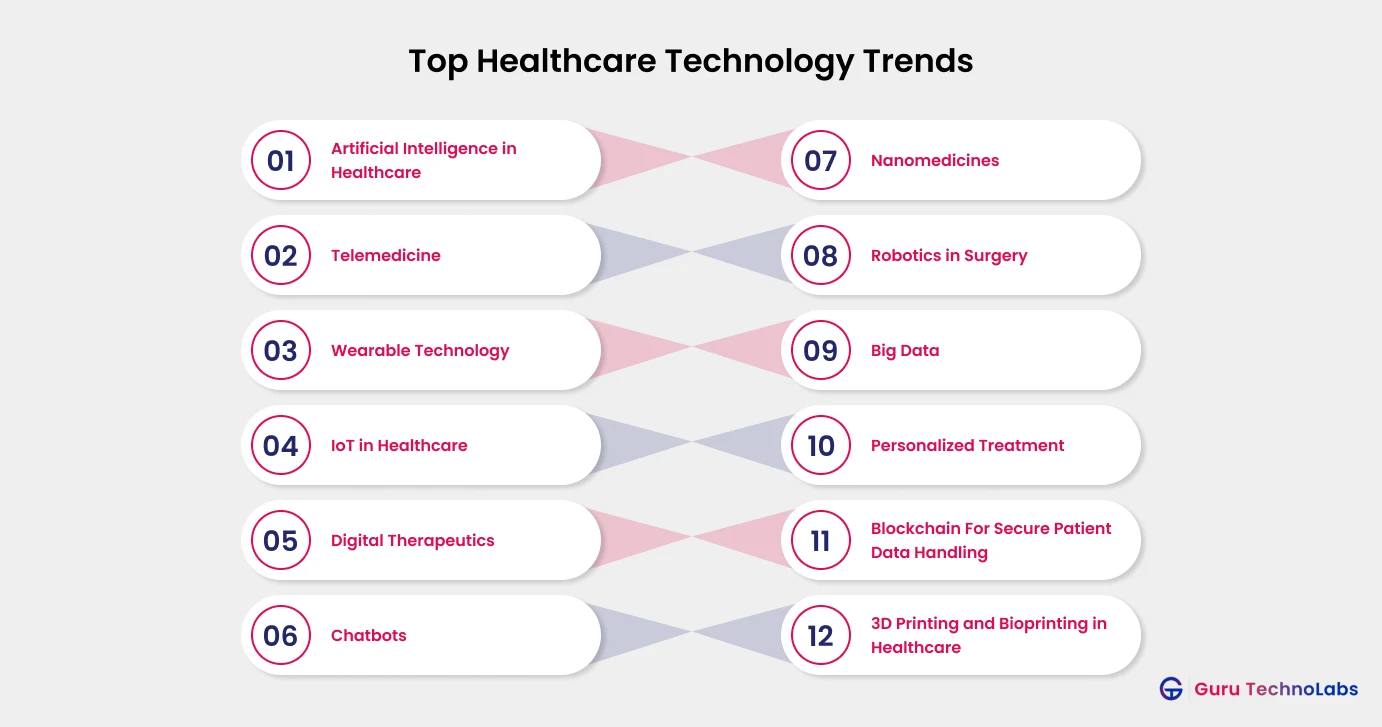
As we journey through 2025, the healthcare landscape is undergoing a remarkable transformation, driven by technological innovations that enhance patient care, streamline operations, and foster personalized experiences. Let’s delve into twelve pivotal trends shaping the future of healthcare:
Personalized Matchmaking
For good reasons, AI has stolen much of the thunder from the experts by providing unrivaled results, particularly in healthcare. AI in healthcare is swift and effective data analysis that leads to enhanced, impartial diagnostics, as human healthcare professionals handle enormous volumes of data at work daily, which can be overwhelming.
Since it enables the type of machine learning that can detect diseases early, one of the biggest advantages of this healthcare trend is that it can allow patients to heal from the illness before irreversible damage can happen.
For example, some of Google’s AI models were more accurately predicting breast cancer through their mammography screenings compared to conventional methods, which help to detect breast cancer when it is most treatable and leads to a 90% survival rate when at stage one.
This not only accelerates diagnostics, helping physicians better manage care with fewer errors.
2) Telemedicine: Redefining Patient-Provider Interactions
The pandemic had fast-tracked the use of telemedicine, which, in 2025, had become the norm for consultations. Patients now interact with healthcare providers through secure video conferencing, minimizing the requirement for in-person visits and enhancing accessibility to healthcare services. With the integration of AI in telemedicine, providers can now deliver more accurate diagnoses, predictive insights, and personalized care remotely.
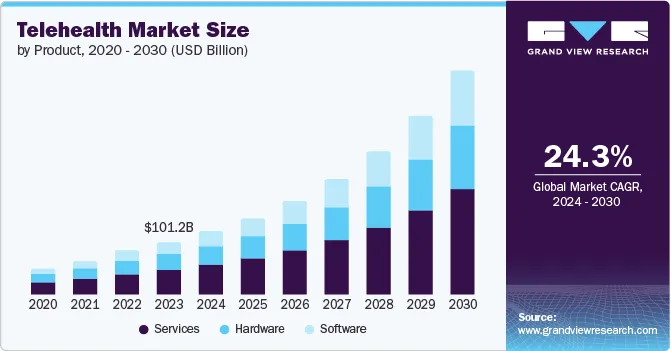
Source: Grand View Research
Companies such as Teladoc Health have shown a huge uptick in virtual visits, signaling a trend in favor of remote care. This trend mirrors the broader consumer expectations for convenience and personalized services in healthcare.
There are no boundaries to health innovation, and “digital twins” are just another popular gimmick. This involves merging live data with more sophisticated physical models, like a patient’s anatomy or organs, to develop virtual twins. These contemporary instruments are utilized in individualized treatment planning, validating the effectiveness of medical interventions, and anticipating potential health sequences.
3) Wearable Technology: Empowering Patients with Real-Time Health Monitoring
Wellness and remote health tracking apps are on the rise and will remain popular well into 2025 and beyond. The Google Play or iTunes store has numerous healthcare mobile apps for wellness and wearable devices.
That being said, some smartphone apps can sync with wearables like fitness trackers and pulsometers and even analyze your body metrics on the basis of information taken from your sensors, including blood pressure, body temperature, pulse, and several other metrics.
From fitness trackers to advanced health monitoring devices, wearable has come a long way. Devices such as smartwatches and fitness trackers will, by 2025, collect data on heart rate, sleep patterns and physical activity — providing information as events unfold.
Such constant monitoring helps in identifying the underlying health problems at the time, resulting in timely interventions. Wearables, for instance, allow users to be alerted to irregular heart rhythms and seek out medical consultation preemptively.
4) IoT in Healthcare: Enhancing Remote Care and Data Sharing
Remote care has seen gradual but continued adoption, maturing from pandemic-driven necessity to a defining aspect of modern health care. Virtual consultations, remote patient monitoring (RPM), and virtual hospital systems are becoming the norm, so healthcare providers are not just relieving the burden of overcrowded facilities, they also offer more patient satisfaction.
Virtual hospitals were rated as a positive experience by as much as 86% of patients and gave patients a higher degree of confidence in the quality of care received remotely, according to a report by McKinsey.
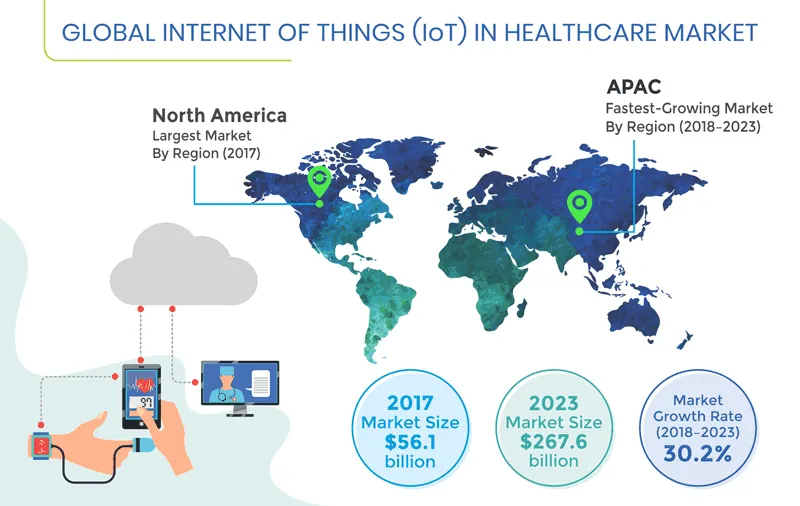
Source: P & S Intelligence
Future of virtual care in 2025: Virtual care will evolve tremendously, powered by IoT, next-gen telemedicine, AI, and cloud computing. This next wave of virtual care will not only enhance how healthcare gets delivered — it will transform it. Patients will benefit from more accessible, data-driven care, while providers will have powerful tools to help manage patient outcomes effectively, creating a healthcare system more responsive to the patient and patient-centric than ever before.
5) Digital Therapeutics: Delivering Personalized and Scalable Interventions
Digital therapeutics (DTx) offer evidence-based therapeutic interventions through software, addressing conditions such as diabetes, hypertension, and mental health disorders. In 2025, DTx platforms will provide personalized treatment plans, real-time feedback, and support, improving patient engagement and adherence.
Companies like Biofourmis utilize wearable devices and automated medication management to deliver tailored interventions for chronic heart conditions. This trend signifies a shift toward personalized, patient-centric care models in the digital age.
These trends exemplify how technology is reshaping healthcare, making it more personalized, efficient, and accessible. As we progress through 2025, embracing these innovations will be crucial for providers aiming to meet evolving patient expectations and navigate the dynamic healthcare landscape effectively.
6) Chatbots
Chatbots have evolved from simple automated responses to smart assistants capable of handling complex healthcare queries. They’re like having a friendly, knowledgeable companion available 24/7, ready to help with everything from booking appointments to offering medical advice.
For instance, Buoy Health is an AI-powered chatbot that guides users through their health concerns. It helps users assess symptoms, provides advice, and even directs them to the right healthcare provider.
Chatbots reduce wait times, improve accessibility, and allow healthcare professionals to focus on more critical cases. Imagine needing quick medical advice at 2 AM without waiting on hold for hours. Chatbots make that possible, turning what used to be a frustrating process into an effortless one.
Transform Your Healthcare Business Today!
Contact us now for custom healthcare solutions and expert consultation to
unlock your business’s full potential!
7) Nanomedicines: Tiny Tech, Big Impact
Nanomedicine is revolutionizing how we treat diseases by using microscopic particles that can target specific cells with incredible precision. This approach minimizes damage to healthy tissues and maximizes the effectiveness of treatments.
Doxil, a chemotherapy drug, uses nanoparticles to target cancer cells directly, reducing side effects compared to traditional chemotherapy. It enhances drug delivery efficiency, reduces treatment-related side effects, and opens new possibilities for targeting hard-to-treat diseases.
Think of it as a GPS for medicine—delivering treatment exactly where it’s needed without any detours. That’s the power of nanomedicine.
8) Robotics in Surgery: Precision Beyond Human Limits
Robotic surgery isn’t about replacing doctors; it’s about giving them superhuman precision. Systems like the da Vinci Surgical System allow surgeons to perform complex procedures through small incisions, reducing recovery time and improving surgical outcomes.
For instance, the da Vinci Surgical System is used globally for procedures ranging from heart surgeries to minimally invasive gynecological operations.
It reduces the risk of complications, minimizes blood loss, and speeds up recovery. Imagine a surgeon operating with the steadiness of a robot’s mechanical arms, making every cut with pinpoint accuracy. That’s the magic behind robotic surgery.
9) Big Data: Turning Information into Action
Big Data isn’t just about numbers – it’s about uncovering patterns that can change lives. In healthcare, it helps doctors make better decisions, predict disease outbreaks, and personalize treatment plans.
For instance, IBM Watson Health analyzes vast amounts of medical data to assist doctors in diagnosing cancer and recommending treatments.
It helps identify trends, improve patient outcomes, and optimize hospital operations. It’s like having a super-powered brain that remembers every patient’s detail, cross-references medical literature, and provides recommendations in seconds.
10) Personalized Treatment: Medicine Tailored to You
Personalized treatment is shifting healthcare from a one-size-fits-all model to a customized approach based on your genetics, environment, and lifestyle. This ensures that treatments are more effective and have fewer side effects.
CAR T-cell therapy is a revolutionary cancer treatment where a patient’s immune cells are reprogrammed to target cancer cells effectively. It improves treatment efficacy, reduces side effects, and offers hope for patients with previously untreatable conditions.
Think of it as having a suit tailored just for you—every part fits perfectly because it was designed with you in mind. That’s what personalized medicine does.
11) Blockchain For Secure Patient Data Handling
Blockchain isn’t just for cryptocurrencies; it’s transforming healthcare by providing secure, transparent, and tamper-proof ways to manage patient data.
For instance, Medicalchain uses blockchain to securely store and share patient records across different healthcare providers. It ensures data privacy, reduces fraud, and enhances trust in digital health systems.
Imagine a digital vault where your medical records are locked tight, accessible to only authorized professionals, with a clear record of who accessed your data and when. That’s blockchain in action.
12) 3D Printing and Bioprinting in Healthcare
3D printing isn’t just for creating cool gadgets – it’s changing healthcare from its roots. From custom prosthetics to bioprinted tissues, this technology is making personalized medicine more accessible.
For instance, this technology allows custom healthcare solutions, reduces costs, and advances regenerative medicine. Imagine getting a prosthetic limb that fits perfectly because it was 3D printed just for you. That’s the future of personalized healthcare.
Riding The Wave Of Digital Transformation In Healthcare With Guru TechnoLabs
Digital transformation is undeniably here to stay, and its impact has touched every industry, including healthcare. From patient care to operational efficiency, technology has reshaped how healthcare systems operate, making them more accessible, efficient, and data-driven. In a world where innovation is key to staying competitive, healthcare providers must embrace these changes or risk being left behind.
As a leading healthcare app development company, we understand that every healthcare business is unique, and we’re here to help you navigate this digital evolution. If you’re about to enter this transformative journey, we specialize in creating custom healthcare solutions tailored to your specific needs. Contact us today for consultation, and let’ s work together to determine the best approach to meet your business’s goals in this ever-evolving digital world.
Frequently Asked Questions
Digital transformation is improving patient care, increasing efficiency, and enhancing data management through technologies like AI, telemedicine, and electronic health records.
Key trends include AI for diagnostics, telemedicine for remote consultation, blockchain for secure data, and wearable devices for continuous health monitoring.
Digital transformation helps healthcare businesses stay competitive, improve patient care, reduce costs, and streamline operations through data-driven solutions.
Yes, small healthcare businesses can enhance patient care, reduce costs, and increase efficiency by adopting affordable, scalable technologies like telemedicine and cloud solutions.
They should assess their specific needs, budget, and regulatory compliance, and ensure the technology integrates smoothly with existing systems for maximum benefit.



